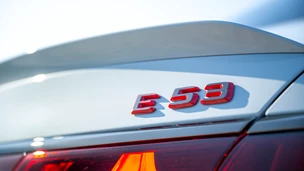The RS 3 is a high-performance version of the five-door A3 Sportback, fitted with a 362bhp 2.5-litre five-cylinder turbo petrol engine which drives all four wheels through a seven-speed S tronic semi-automatic gearbox. Its closest relation, and one of its greatest competitors, is the Volkswagen Golf R, which is slower but cheaper and can be had with three or five doors and manual or automatic transmission, a range of choice not offered by Audi.
Other rivals include the Mercedes A 45 AMG and the forthcoming Ford Focus RS. Along with the Golf, they form strong opposition, but the RS 3 is an excellent car which bears comparison with anything else in the class.
Like the even faster RS 6, the RS 4 is now available only in estate form, Audi having decided not to persevere with the previous saloon and convertible versions.
Only one drivetrain is offered. It consists of a naturally aspirated 4.2-litre V8 petrol engine which produces 444bhp at the notably high speed of 8,250rpm and drives all four wheels through a seven-speed automatic gearbox. The most obvious rival is the Mercedes C63 AMG, which is both more expensive and more powerful and drives through the rear wheels only.
Performance
Perhaps the single most impressive feature of the RS 4 is its engine, which is one of the most thrilling on the market. Without the benefit of turbocharging, it requires high revs to work at its best, and as you take it towards the red line it produces a quite fabulous scream.
Less energetic driving produces more modest results - at 4,000rpm the engine produces 241bhp, little more than half the total possible amount, and it fades out still further at lower revs. For road use, it's still adequately strong, but you can't perform a really quick overtaking manoeuvre without creating sound effects which might annoy other drivers.
The automatic transmission shifts up very cleanly and can be persuaded to select a lower gear quite happily when you're decelerating hard, while the brakes allow you to lose speed very quickly when required.
Ride and Handling
It feels very relaxed on public roads, and a heavy application of the power in the middle of a corner on a race track produces no understeer at all and a rear-end shimmy which is so slight it requires no correction.
Audi has had to compromise the RS 4's rear suspension to allow for the possibility that owners might want to carry heavy loads, and there's no doubt that a saloon version, if one existed, would feel a little more precise. For an estate, though, the car handles brilliantly. It feels very relaxed on public roads, and a heavy application of the power in the middle of a corner on a race track produces no understeer at all and a rear-end shimmy which is so slight it requires no correction. Small bumps create a small amount of shake through the steering wheel, though this is probably due to the very low-profile tyres more than anything else.
Interior and Equipment
Including a short-lived model sold at the turn of the century, this is Audi's third RS 4. Only the first-generation was turbocharged.
The RS 4 matches the Mercedes AMG's 490 litres of luggage space when the rear seats are up. With the rear seats down, capacity increases to 1,430 litres, which is a lot but also falls short of the Mercedes by 80 litres. As standard, the Audi has part-leather upholstery, satellite navigation, DAB digital radio, cruise control, roof rails, adaptive highlights and rear parking sensors. The sports seats up front provide adequate support, given the car's high cornering ability, though for a car costing well over £50,000 it's disappointing that their height adjustment is manual rather than electric. More positively, Audi provides customers with a space-saver spare wheel, which is a lot more useful than the alternative of a tyre repair kit.
Cost
Mercedes has got both its cars under 200g/km, while the Audi is rated at 249g/km and will therefore cost £490 rather than £265 per year to tax.
In its basic form, the RS 4 costs just over £56,500, usefully less than the less powerful variant of the C63 and nearly £10,000 short of the faster C63 S. The Audi loses out badly in terms of on-paper running costs, though, since the turbocharged Mercedes is never on boost during the EU fuel economy test - at 26.4mpg, the RS 4 is more than 7mpg short of both the AMGs. They will be closer in real life, but that doesn't alter the fact that Vehicle Excise Duty is based on the official CO2 results. Mercedes has got both its cars under 200g/km, while the Audi is rated at 249g/km and will therefore cost £490 rather than £265 per year to tax. Mercedes also currently has a three percentage point advantage for Benefit In Kind taxation, though all these cars will be rated at the maximum 37 per cent from April 2017.
Our Verdict
In the context of their market sectors, the RS 4 isn't quite as impressive as the RS 6, largely because Audi's decision to avoid turbocharging the smaller car has had a big effect on the tax situation. It's quite possible, however, that customers will consider its wonderful sound effects to be worth the extra expense, and in any case when they're revelling in the superb handling they probably won't be paying too much attention to such mundane matters.




